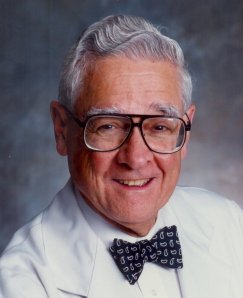
Dr. Thomas N. James, a research cardiologist whose focus on basic research led to several breakthroughs in the treatment of heart disease, died September 11, 2010, at his home in Birmingham, Ala. He was 84.
Born in Amory, Mississippi, on October 24, 1925, Dr. James was the oldest of five children of Naum and Kata Evanova James. He attended Amory High School. A bout with malaria at the age of 12 aroused his interest in medical research, when a nurse showed him his own blood under a microscope. Six years later, he won a Westinghouse scholarship to Tulane University in New Orleans, where he took his medical doctorate in 1949. On June 22, 1948, he married Gleaves Elizabeth Tynes in New Orleans; three boys were born to this couple.
From 1949 to 1953, Dr. James did his internship and residency at the Henry Ford Hospital in Detroit, after which he enlisted in the United States Army Medical Corps and was stationed for two years at the army hospital in Osaka, Japan, where he rose to the rank of captain. Returning to New Orleans in 1955, he worked at the Ochsner Clinic there until 1959, when the Henry Ford Hospital recruited him back to head their cardiology department. From 1968 to 1987, he taught at the University of Alabama at Birmingham, where he also served as chairman of the Department of Medicine for seven years.
In 1987, the University of Texas Medical Branch (UTMB) at Galveston named Dr. James as its president, a position that he held for ten years. Thereafter, he returned to full-time research at UTMB. He retired to Birmingham in 2004, when declining eyesight compelled him to turn off his beloved microscope for the last time.
In a career that encompassed patient care, university administration, and the training of hundreds of cardiologists, Dr. James remained passionately devoted to fundamental research. His seminal textbook, Anatomy of the Coronary Arteries, published in 1961, made his name and paved the way for novel treatments such as bypass surgery and stents. Dr. James’s interest later turned to the electrical conduction system of the heart. His many publications in this area traced electrical pathways (two of which are named for him), and led to refinements in cardiac pacemaker design.
These discoveries brought Dr. James to national and international prominence in the field of cardiology. In 1979 he was elected president of the American Heart Association; in 1982 he became president of the International Society and Federation of Cardiology; and in 1986 he presided over the tenth World Congress of Cardiology — only the second American ever so honored. From 1988 to 1998 he served as director of the Cardiovascular Center of the World Health Organization.
Dr. James enjoyed enormous respect in his field. Elected a Master of the American College of Physicians, he was honored with over two hundred awards and invited lectureships all over the world. His legacy includes 472 publications, over half a million photomicrographs, and two generations of cardiologists who benefited from Dr. James’s inspiring example, supported by the highest standards of objective scientific training.
Dr. James was preceded in death by his parents, his sister Helen Pipher, and his brother Philip. He is survived by his wife Gleaves; a sister, Mary James (of New York City); a brother, Norman (of Amory, Miss.); three sons, Mark (and wife Marine Le Minor, of Auckland, New Zealand), Terry (and wife Loryn, of Birmingham, Ala.), and Peter (and wife Gigi, of Sterrett, Ala.); and grandchildren Matthew, Sara, Tommy, Elizabeth, and Alexis.